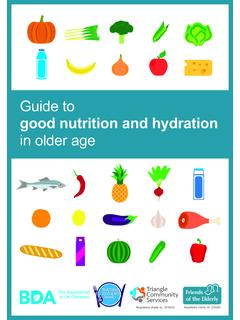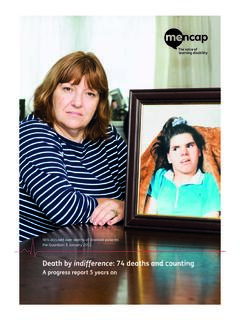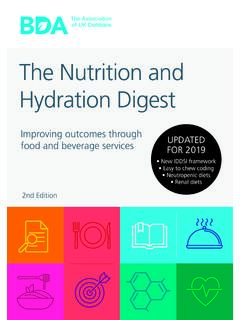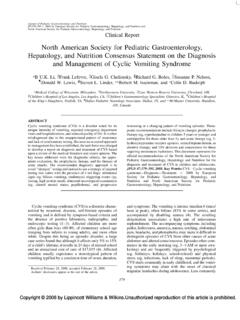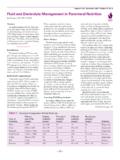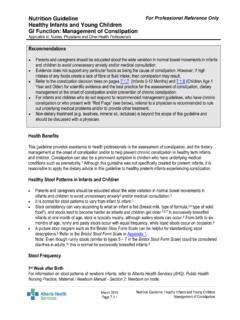Transcription of Safeguarding Adults - NHS England
1 Safeguarding AdultsThe Care Act 2014 Your ResponsibilitiesHuman TraffickingYour Role as the Person Raising Concern Information SharingThe Mental Capacity ActAssessing Capacity ChartDeprivation of Liberty SafeguardsPressure Ulcer StagingPrevent/ChannelFemale Genital MutilationModern SlaveryDomestic Violence and AbuseThe Care Act 20141sets outstatutory responsibility for theintegration of care and supportbetween health and localauthorities. NHS England andClinical Commissioning Groups areworking in partnership with localand neighbouring social careservices. Local Authorities havestatutory responsibility forsafeguarding. In partnership withhealth they have a duty to promotewellbeing within local communities. The Care Act 2014 What is safeguardingadults and why it matters2 Safeguarding Adults meansprotecting a person s right to live in safety, free from abuse andneglect. The Care Act requires that each Local Authority must: Arrange, where appropriate, for an independent advocate to represent and support an adult who is the subject of a Safeguarding enquiry Or Safeguarding Adult Review where the adult has substantial difficulty in being involved in the process and where there is no other appropriate adult to help them Cooperate with each of its relevant partners in order to protect Adults experiencing or at risk of abuse or adult at risk is any person who is aged 18 years or over and at risk of abuse or neglectbecause of their needs for careand or support.
2 Where someone is over 18 but still receivingchildren s services and asafeguarding issue is raised, the matter should be dealt with as a matter of course by the adult Safeguarding team. Make enquiries, or ensure others do so, if it believes an adult is experiencing, or is at risk of, abuse or neglect An enquiry should establish whether any action needs to be taken to stop abuse or neglect, and if so, by whom Set up a Safeguarding Adults Board Continued on next Care Act 2014 The aims of Safeguarding adultsare: To prevent harm and reduce the risk of abuse or neglect to Adults with care and support needs To safeguard individuals in a way that supports them in making choices and having control in how they choose to live their lives Making Safeguarding Personal To promote an outcomes approach in Safeguarding that works for people resulting in the best experience possible To raise public awareness so that professionals, other staff and communities as a whole play their part in preventing, identifying and responding to abuse and order to achieve these aims,it is necessary: To ensure that the roles and responsibilities of individuals and organisations are clearly laid out.
3 To create a strong multi-agency framework for Safeguarding . To enable access to mainstream community safety measures. To clarify the interface between Safeguarding and quality of service adultsAll staff within health services have a responsibility for the safety andwellbeing of patients and a life that is free fromharm and abuse is a fundamentalhuman right and an essentialrequirement for health and Adults is about thesafety and well-being of all patientsbut providing additional measuresfor those least able to protectthemselves from harm or Adults is afundamental part of patient safetyand wellbeing and the outcomesexpected of the NHS. Safeguardingadults is also integral to complyingwith legislation, regulations anddelivering cost effective cards should be used byyou as a guide should you havea Safeguarding concern andshould always be used alongsideyour organisation s safeguardingpolicy and of an adult at risk:Aged 18 years or over;Who may be in need of communitycare services by reason of mental orother disability, age or illness; andwho is or may be unable to takecare of him or herself, or unableto protect him or herself againstsignificant harm or : Throughout this publicationwe have used the term patient to refer to patients and responsibilitieswhen you havesafeguarding concerns: Assess the situation are emergency services required?
4 Ensure the safety and wellbeing of the individual Establish what the individual s views and wishes are about the Safeguarding issue and procedure Maintain any evidence Follow local procedures for reporting incidents/risks Remain calm and try not to show any shock or disbelief Listen carefully and demonstrate understanding by acknowledging regret and concern that this has happened Inform the person that you are required to share the information, explaining what information will be shared and why Make a written record of what the person has told you, using their words, what you have seen and your ResponsibilitiesContinued on next of care: You have a duty of care to yourpatients/service users and yourcolleagues. Safeguarding iseverybody s Health Professions Councilstandards state: ..a person who is capable of givingtheir consent has the right to refusetreatment.
5 You must respect thisright. You must also make sure they are fully aware of the risk ofrefusing treatment, particularly ifyou think there is a significant orimmediate risk to life. Duty of care can be said to havereasonably been met where anobjective group of professionalconsiders. All reasonable steps have been taken Reliable assessment methods have been used Information has been collated and thoroughly evaluated Decisions are recorded, communicated and thoroughly evaluated Policies and procedures have been followed Practitioners and managers seek to ascertain the facts and are proactive. You should always treat everyindividual with dignity and respectto ensure that they feel safe inservices and empowered to make choices and that significant others, family member, friend oradvocate, are involved to supportthe individual where is important to recognise thatthough an individual with capacityhas the right to refuse care forthemselves.
6 Such a refusal maygive raise a Safeguarding concernin respect of have the responsibilityto follow the 6 safeguardingprinciples enshrined withinthe Care Act 2014:Six key principles underpin alladult Safeguarding work:Principle 1 Empowerment Personalisation and the presumption of person-leddecisions and informed consent. I am asked what I want as theoutcomes from the safeguardingprocess and these directly informwhat happens. Continued ResponsibilitiesPrinciple 2 Prevention It is better to takeaction before harm occurs. I receive clear and simpleinformation about what abuse is,how to recognise the signs and what I can do to seek help. Principle 3 Proportionality Proportionate andleast intrusive response appropriateto the risk presented. I am sure that the professionals will work for my best interests, as I see them and they will only get involved as much as I require. Principle 4 Protection Support andrepresentation for those in greatest need.
7 I get help and support to reportabuse. I get help to take part in thesafeguarding process to the extent to which I want and to which I amable. Principle 5 Partnership Local solutions through services working with theircommunities. Communities have apart to play in preventing, detectingand reporting neglect and abuse. I know that staff treat anypersonal and sensitive informationin confidence, only sharing what is helpful and necessary. I am confident that professionals willwork together to get the best result for me. Principle 6 Accountability Accountabilityand transparency in deliveringsafeguarding. I understand the role of everyoneinvolved in my life. 1. Categories of AbuseAbuse and neglect can take manyforms. Organisations and individualsshould not be constrained in theirview of what constitutes abuse orneglect, and should alwaysconsider the circumstances of theindividual case. Abuse includes:Physical abuse including assaulthitting, slapping, pushing, misuseof medication, restraint orinappropriate physical abuse including rape andsexual assault or sexual acts towhich the adult has not consentedor was pressured into abuse includingemotional abuse, threats of harm or abandonment, deprivation ofcontact, humiliation, blaming,controlling, intimidation, coercion,harassment, verbal abuse, isolationor unreasonable and unjustifiedwithdrawal of services orsupportive ResponsibilitiesContinued on next Slavery See humantrafficking section.
8 Financial or material abuse including theft, fraud, exploitation,coercion in relation to an adult sfinancial affairs or arrangements,including in connection with wills,property, inheritance or financialtransactions, or the misuse ormisappropriation of property,possessions or and acts of omission including ignoring medical orphysical care needs, failure toprovide access to appropriatehealth, care and support oreducational services, thewithholding of the necessities of life, such as medication,adequate nutrition and Neglect this covers a widerange of behaviour neglecting tocare for one s personal hygiene,health or surrounding and includesbehaviour such as hoarding. It isimportant to consider capacity when self-neglect is suspected. Also consider how it may impact on other family members andwhether this gives rise to asafeguarding concern. Domestic Violence See DV SectionDiscriminatory abuse includingdiscrimination on grounds of race,gender and gender identity, disability,sexual orientation, religion, and otherforms of harassment, slurs or abuse includingneglect and poor care practicewithin an institution or specific caresetting like a hospital or care home, this may range from isolatedincidents to continuing Safeguarding AdultReviewsCommissioners and the NHS haverobust processes in place to learnlessons from cases where children oradults die or are seriously harmed and abuse or neglect is Adults this include contributingfully to Safeguarding Adult Reviews(SARs) which are commissioned by theLocal Safeguarding Adult Board (LSAB).
9 ( Safeguarding Vulnerable People inthe Reformed NHS Accountability and Assurance Framework)33. Whistle blowingAlways act whenever abuse issuspected including when yourlegitimate concern is not actedupon. Whistle blowers are givenprotection under the Public Interest Disclosure Act in doubt contact your nominatedlead for adult Safeguarding forassistance and ResponsibilitiesYour role as Alerter in the Safeguarding Process The person who raises a Safeguarding concern within their own agency should follow their own policy and procedures This concern may result from something that you have seen, been told or heard Make a Safeguarding Adult referral where this is assessment should be holistic and thorough considering the patient s emotional, social,psychological and physicalpresentation as well as the identifiedclinical need. You need to be alert to: The patients views and wishes Inconsistencies in the history or explanation Skin integrity hydration Personal presentation is the person unkempt Delays or evidence of obstacles in seeking or receiving treatment Evidence of frequent attendances to health services or repeated failure to attend (DNA)Your Role as the Person Raising Concern Environmental factors eg.
10 Signs of neglect, the reactions and responses of other people with the patient Does the patient have capacity for the decision required? Are they able to give informed consent or is action needed in their best interests? Are there others at risk children or other vulnerable Adults ? Is immediate protection required? Has a crime been committed and should the Police be informed? Preserving any evidence Is any action that is being considered proportionate to the risk identified? Cultural differences or religious beliefs Are there valid reasons to act even without the patient s consent? where others are at risk; need to address a service failure that may affect on next rules: Holistic assessmentOn admission or initialcontact: Does this fall under adult Safeguarding Adults duties as defined by the Care Act 2014? Are there any existing Safeguarding alerts relating to the patient?










